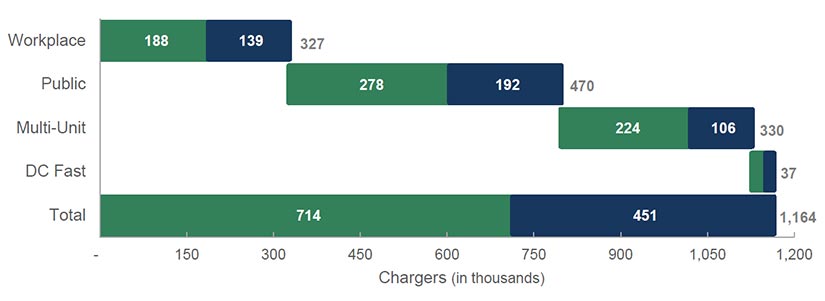Charging Infrastructure Analysis Aims To Help California Meet Zero-Emission Vehicle Goals
Analysis Leverages NREL Data Science Expertise and State-of-the-Art Modeling Tools
Leveraging its data science expertise and state-of-the-art modeling and analysis tools, the National Renewable Energy Laboratory (NREL) is helping the California Energy Commission (CEC) pinpoint the number of electric vehicle (EV) chargers needed to meet the state’s ambitious zero-emission vehicle (ZEV) and greenhouse gas (GHG) reduction goals.
NREL’s infrastructure analysis focuses on meeting the state’s goal, set with Assembly Bill 2127 in 2018, of putting at least 5 million light-duty ZEVs on California roads and reducing GHG emissions to 40% below 1990 levels by 2030. It also accounts for additional ZEV targets, set in 2020 with Executive Order N-79-20, for ZEVs to comprise all new passenger vehicle sales in California by 2035. These targets aim to combat the state’s greenhouse gas emissions—50% of which are attributed to transportation.
“NREL’s infrastructure analysis, which focuses on light-duty vehicles, suggests that up to 1.2 million chargers—beyond those located at single-family homes—may be necessary to support California’s ZEV goals,” said Eric Wood, an NREL data science research engineer. “This represents a dramatic increase from the 70,000 public and shared private chargers operating in the state today.”

“California’s ZEV goals call for a dramatic shift in transportation infrastructure, necessitating an unprecedented investment in residential, destination, and fast-charging infrastructure,” Wood added. “In addition to identifying the number of chargers needed, NREL’s analysis is identifying efficient charging station locations as well as ways to mitigate the impact of charging loads on the electric grid—by tapping into renewable energy and employing smart-charge technologies, for instance.”
In July 2021, the CEC released its “EV Charging Infrastructure Assessment—Analyzing Charging Needs to Support ZEVs in 2030” report, which was informed by NREL’s analysis.
Integrated Data and Analysis Tools
“NREL has a long history of working with the CEC on infrastructure analyses,” Wood said. “We developed one of the primary tools used in this analysis—the Electric Vehicle Infrastructure Projection (EVI-Pro) tool—in partnership with the CEC in 2016 and have been using it and refining it ever since.”
EVI-Pro is used to analyze typical daily travel patterns of light-duty vehicles, estimate related charging demand, and design infrastructure capable of meeting the demand. It accounts for variations and uncertainty in vehicle and charger technologies, user demographics, market adoption conditions, the shared use of chargers, and EV travel and charging preferences.
The California analysis also employed NREL’s EVI-RoadTrip tool for analyzing the charging infrastructure needed for long-distance road trips. Additionally, it drew on real-world travel data from NREL’s Transportation Secure Data Center and leveraged other tools—the Future Automotive Systems Technology Simulator (FASTSim) the Route Energy Prediction Model (RouteE), and the Automotive Deployment Options Projection Tool (ADOPT)—in NREL’s arsenal of integrated modeling and analysis tools.
NREL has conducted numerous EV infrastructure studies in states and regions across the country to inform the development of large-scale EV infrastructure deployments. Understanding the charging requirements of current and future EV owners—as well as the regulations impacting a given state or region—influence the development of successful charging networks that fit the needs of users and station owners alike without putting undue strain on the utility grid.
Learn more about NREL’s sustainable transportation and mobility research.
Last Updated May 28, 2025
